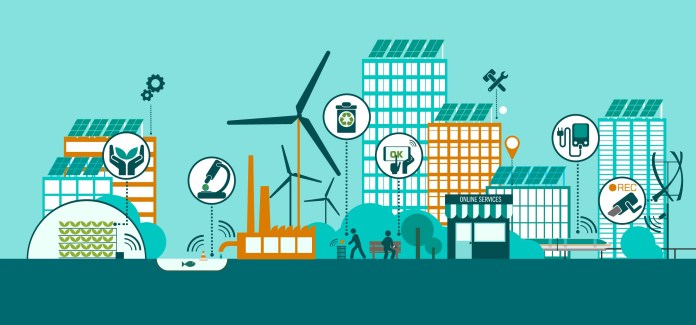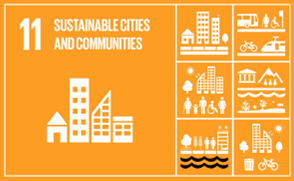The technology carried on humankind to a high level, making it able to shape the environment according to your needs. This has spread a veil in front of the eyes that did not allow us to realize the great changes that it is bringing along. For this reason, a new way of urban planning is needed, looking at the concept of Smart city, where everything is linked by the Internet of Things through sensors, cameras and a different kind of human behaviour.

“A smart city is a place where traditional networks and services are made more efficient with the use of digital and telecommunication technologies for the benefit of its inhabitants and business” ~ European Commission
Nowadays, the way of urban planning cities is no longer compatible with the advance of human expansion in technological progress and in the achievement of well-being. It is estimated that the world population is going to increase to around 10 billion people by 2050 and almost 70% of them will be residing in cities, compared to 58% of them nowadays. The consequence is a remarkable expansion of the space already occupied by the urban environment. But cities use less than 2% of the earth’s surface, so what is meant by expansion? Well, the problem lies in the conspicuous consumption of resources to keep the urban agglomerations alive and functioning, which matches more than 75% of the natural resources available globally.
The answer to these prospects is Smart Cities, which have come up as a possible solution to problems derived from rapid urbanization from the point of view of sustainability in its three pillars: social, economic, and environmental. This way of thinking on urban planning is relatively new, it is the successor of information city, digital city and intelligent city. The concept could be an umbrella that contains several sub themes such as smart urbanism, economy, environment, technology, energy, mobility, health and so on. These aspects define sustainable urban development as a balance among the development of the urban spaces and protection of the environment, looking at the equity in income, employment, basic services, social infrastructure, and transportation.
This transformation is considered essential by policymakers and is the topic established in the 11th UN Sustainable Development Goal (SDG), aiming at making cities inclusive, safe, resilient, and sustainable. The European Commission alone has put in a budget of one billion euros on smart city projects, for the period 2014–2020.

The smart city uses the idea of using its own technology and data with define purpose to get better decisions and provide a better quality of life, carrying on solutions that can give results such as 10-15% fewer GHG emissions, 30-130 fewer kilograms of solid waste per person per year, and 25-80 litres of water saved per person per day. To achieve these targets, mostly pointed to environmental direction, some aspects need to be faced, like climate change, lack of natural resources, globalisation, and increased competition.
First cities need to reduce carbon emissions and pollutants, where the main contribution comes from traffic and house heating. Solutions point to smart alternatives in transportation to make citizens not dependent on their own vehicle for mobility. Public transport, such as buses and the underground, is already preferable if it is punctual, and people do not have to be stuck in the after-work traffic jam or look for parking spaces. One possible solution to crowded streets and polluted air is smart bike-riding services, smart-ride sharing and self-driving, autonomous vehicles which use less fuel. The city car of the future will be small, quiet, and electric. Self-driving cars are already being tested in road traffic today and they are expected to drive themselves on roads and highways by 2030. Bicycles will also play a bigger role in the future and could even replace a large part of car traffic. Indeed, the use of bicycles in large cities is expected to increase by at least 18% in the coming decade. During the corona crisis, the use of bicycles also expanded significantly in Paris: Bicycle traffic increased by 66% from 2019 to 2020.
Architecture also has an important role in this target. Indeed, now there is the conception to reintegrate nature into cities and buildings with more spaces, inner-city nature, urban gardening concepts and so on. One possibility for this is to design buildings able to interact with the city. In Rome, for example, a sustainable “City of Science” is to be created. One example that already exists today is the supertrees in the Gardens by the Bay in Singapore. These vertical gardens are 9-16 stories high and collect rainwater, harvest solar energy and act as ventilation ducts for the greenhouses in the rest of the park.
Another challenge concerns the urban solid waste management. The environment has an incredible self-cleaning capacity, but the cities place an excessive burden on it. It is estimated that the production of USW is around 3.6 million tonnes each day. Smart waste solutions use sensors to know when containers must begin compacting and transfer information with the local waste management company to warn when they need to be emptied. In this way, the activity of garbage trucks is reduced like their carbon emission and pollutants. This idea is already a reality in the city of New York.
Smart cities are characterized by supporting energy efficiency guaranteeing that resources are only used just when they need. The increased energy demand leads to more pollution and a decrease in natural resources. Smart LED streetlights are one of the ways of reducing the demand because they require less energy to work. Some of them can also be dimmed or brightened according to the location and time of day without compromising safety. Norway has scheduled to build a sustainable smart city near Oslo’s airport, powered only with renewable energy with the excess being sold back into the grid and sensor-based systems will enter automatically illuminating streets and buildings.
Internet of Things (IoT) is the technology on which Smart Cities leverage, through connectivity, big data, machine learning and analytics to process energy and environment data such as air pollution levels, water wasted, renewable energy performance and solid waste monitoring. Through sensors and cameras installed in strategic positions as on solar panels, garbage bins or lamppost, data are collected and elaborated to have information that gets real-time monitoring and management of energy and environment. An outstanding example is Amsterdam, where an open database with 12,000 datasets garnered from every urban district has been created. Through its IoT Living Lab, a 3,700-square-meter area fitted with IoT-enabled beacons, users can access data using Bluetooth devices.
The most important gear of the machine is the human factor through citizen engagement. Human behaviour is at the base of environmental problems because there is no awareness, mostly linked to ignorance, on the existing problem. Smart cities are thought for sharing information to promote behavioural change, encouraging people to make sustainable decisions.
All those ideas and conceptions seem to be part of a future come from books or films, but they are closer than expected.
Sources
● https://www.asme.org/topics-resources/content/top-10-growing-smart-cities
● https://mapanauta.medium.com/5-epic-ways-smart-cities-can-help-the-environment-7192d77ff702
● https://www.climateforesight.eu/cities-coasts/environmental-benefits-of-smart-city-solutions/
● https://jopeninnovation.springeropen.com/articles/10.1186/s40852-017-0063-2
● https://www.frontiersin.org/articles/10.3389/fbuil.2020.00077/full

